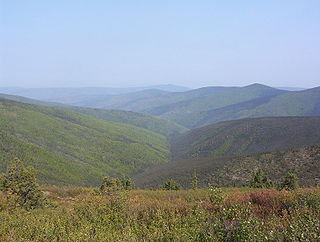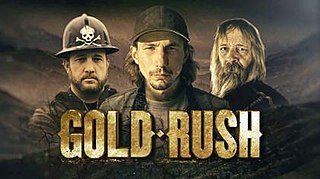
The Five Finger Rapids, also known as the Five Fingers, are located on the Yukon River, Yukon, Canada. Four islands of composite rock divide the river into five narrow channels of which only the eastern is passable.

The Five Finger Rapids, also known as the Five Fingers, are located on the Yukon River, Yukon, Canada. Four islands of composite rock divide the river into five narrow channels of which only the eastern is passable.
Indigenous Canadians called the Five Finger Rapids "Tthi-cho Nadezhe," or "big rocks standing up." [1]
The Five Finger Rapids were a common obstacle for gold seekers during the Klondike Gold Rush; the Yukon River was originally believed to be unnavigable above the rapids. [2] Writer and artist Tappan Adney described them: [3]
"The opening is about one hundred feet wide, with vertical walls, through which the river drops a couple of feet, the waves rising angrily in a return curl, then dancing on in rapidly diminishing chops until lost in the swift current below. We turn our prow squarely for the middle of the cleft; a drop, a smash, a few quarts of water over the sides, and we are shot through into the fast current, without even looking back."
From 1900 to around 1927, blasting was undergone at the rapids, widening the channel by 6 meters (20 feet). [2]
The Five Finger Rapids are mentioned in Jack London's novel The Call of the Wild . The Five Finger Rapids are also mentioned in Alastair Humphrey's novel Thunder and Sunshine . Humphrey's canoe tips while passing through the rapids during his four-year journey around the world by bike. Coordinates: 62°16′10.84″N136°21′1.65″W / 62.2696778°N 136.3504583°W

The Klondike is a region of the territory of Yukon, in northwestern Canada. It lies around the Klondike River, a small river that enters the Yukon River from the east at Dawson City.

The Yukon River is a major watercourse of northwestern North America. From its source in British Columbia, Canada, it flows through Canada's territory of Yukon. The lower half of the river continues westward through the U.S. state of Alaska. The river is 3,190 kilometres (1,980 mi) long and empties into the Bering Sea at the Yukon–Kuskokwim Delta. The average flow is 6,400–7,000 m3/s (230,000–250,000 cu ft/s). The total drainage area is 833,000 km2 (321,500 sq mi), of which 323,800 km2 (125,000 sq mi) lies in Canada. The total area is more than 25% larger than Texas or Alberta.

The Municipality and Borough of Skagway is a first-class borough in Alaska on the Alaska Panhandle. As of the 2020 census, the population was 1,240, up from 968 in 2010. The population doubles in the summer tourist season in order to deal with more than 1,000,000 visitors each year. Incorporated as a borough on June 25, 2007, it was previously a city in the Skagway-Yakutat-Angoon Census Area. The most populated community is the census-designated place of Skagway.

The Klondike Gold Rush was a migration by an estimated 100,000 prospectors to the Klondike region of Yukon, in north-western Canada, between 1896 and 1899. Gold was discovered there by local miners on August 16, 1896; when news reached Seattle and San Francisco the following year, it triggered a stampede of prospectors. Some became wealthy, but the majority went in vain. It has been immortalized in films, literature, and photographs.

Dawson City, officially the City of Dawson, is a town in the Canadian territory of Yukon. It is inseparably linked to the Klondike Gold Rush (1896–99). Its population was 1,577 as of the 2021 census, making it the second-largest town in Yukon.

Edwin Tappan Adney, commonly known as Tappan Adney, was an American-Canadian artist, writer, and photographer.

The Chilkoot Trail is a 33-mile (53 km) trail through the Coast Mountains that leads from Dyea, Alaska, in the United States, to Bennett, British Columbia, in Canada. It was a major access route from the coast to Yukon goldfields in the late 1890s. The trail became obsolete in 1899 when a railway was built from Dyea's neighbor port Skagway along the parallel White Pass trail.

Klondike Gold Rush National Historical Park is a national historical park operated by the National Park Service that seeks to commemorate the Klondike Gold Rush of the late 1890s. Though the gold fields that were the ultimate goal of the stampeders lay in the Yukon Territory, the park comprises staging areas for the trek there and the routes leading in its direction. There are four units, including three in Municipality of Skagway Borough, Alaska and a fourth in the Pioneer Square National Historic District in Seattle, Washington.
Canyon City is a Klondike Gold Rush ghost town and a Yukon Government Heritage Site. It is located about 7 km from downtown Whitehorse, Yukon at the upstream end of Miles Canyon on the Yukon River. Summer tours are encouraged.

The Yukon Field Force, later termed the Yukon Garrison, was a unit of 203 officers and men from the Permanent Force of the Canadian Militia that served in the Yukon between 1898 and 1900. The force was created in the wake of the Klondike Gold Rush in response to fears that the United States might attempt to seize the region. It left Ottawa on May 6, 1898, travelling by rail and sea to the port of Glenora in British Columbia. From there, the unit made an arduous journey of 890 kilometres (550 mi) on foot and using makeshift boats to Fort Selkirk, where they established their headquarters. A detachment of 72 men was sent to the boom town of Dawson City to support the North-West Mounted Police, with duties that included guarding the gold deposits of the local banks. As the fears of an annexation reduced, pressures grew for the recall of the force. The force was halved in size in July 1898 and the remainder were finally withdrawn in June 1900.
Big Island, Nova Scotia is a peninsula located in Pictou County, Nova Scotia. Prospector Robert Henderson of Big Island brought the first gold out of the Klondike in 1896, leading indirectly to the Klondike Gold Rush.

Gold Rush is a reality television series that airs on Discovery and its affiliates worldwide. The series follows the placer gold mining efforts of various family-run mining companies, mostly in the Klondike region of Dawson City, Yukon, Canada, as well as in the U.S. state of Alaska. In its 12th season as of early 2021, prior seasons also included mining efforts in South America and western North America.

Alexander "Big Alex" McDonald (1859–1909) was a Canadian gold prospector who made a fortune in the Klondike Gold Rush, earning himself the title "King of the Klondike".

The Nome Gold Rush was a gold rush in Nome, Alaska, approximately 1899–1909. It is separated from other gold rushes by the ease with which gold could be obtained. Much of the gold was lying in the beach sand of the landing place and could be recovered without any need for a claim. Nome was a sea port without a harbor, and the biggest town in Alaska.
The Klondike Gold Rush is commemorated through film, literature, historical parks etc.

The SS Keno is a preserved historic sternwheel paddle steamer, a National Historic Site of Canada, and a unit of the Canadian national park system. The SS Keno is berthed in a dry dock on the waterfront of the Yukon River in Dawson City, Yukon, Canada.

Klondike is a three-part miniseries about the Klondike Gold Rush that was broadcast by the Discovery Channel on January 20–22, 2014. Based on Charlotte Gray's novel Gold Diggers: Striking It Rich in the Klondike, it is the Discovery Channel's first scripted miniseries. Klondike was directed by Simon Cellan Jones and stars Richard Madden as Bill Haskell, a real-life adventurer who traveled to Yukon, Canada, in the late 1890s during the gold rush.

Dredge No. 4 is a wooden-hulled bucketline sluice dredge that mined placer gold on the Yukon River from 1913 until 1959. It is now located along Bonanza Creek Road 13 kilometres (8.1 mi) south of the Klondike Highway near Dawson City, Yukon, where it is preserved as one of the National Historic Sites of Canada. It is the largest wooden-hulled dredge in North America.

The history of the North-West Mounted Police in the Canadian north describes the activities of the North-West Mounted Police in the North-West Territories at the end of the 19th century and the start of the 20th. The mounted police had been established to control the prairies along the Canadian-United States border in 1873, but were then also deployed to control the Yukon region during the Klondike Gold Rush, and subsequently expanded their operations into the Hudson Bay area and the far north. The force was amalgamated in 1920 to form part of the new Royal Canadian Mounted Police, who continued their predecessors' work across the region.

Klondike City was a Klondike gold rush era settlement on the outskirts of Dawson City in the Yukon Territory. It was renowned for prostitution. The area is mentioned in Jack London's novel White Fang. O'Brien Brewing and Malting Company was located in Klondike City. It was majority owned by Thomas W. O’Brien, who was also a landowner.